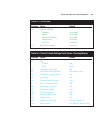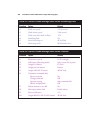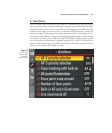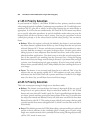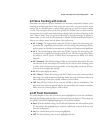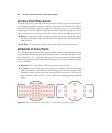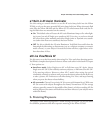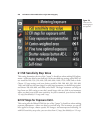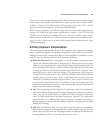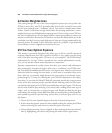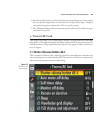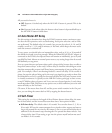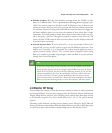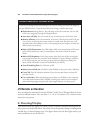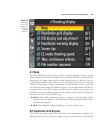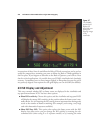Choose the 1/3 stop setting when you want the finest increments between shutter speeds
and/or f/stops. For example, the D7000 will use shutter speeds such as 1/60th, 1/80th,
1/100th, 1/125th, and 1/160th second, and f/stops such as f/5.6, f/6.3, f/7.1, and f/8,
giving you (and the autoexposure system) maximum flexibility.
With 1/2-stop increments, you will have larger and more noticeable changes between
settings. The D7000 will apply shutter speeds such as 1/60th, 1/125th, 1/250th, and
1/500th second, and f/stops including f/5.6, f/6.7, f/8, f/9.5, and f/11. These coarser
adjustments are useful when you want more dramatic changes between different expo-
sures, or want to create a series of more widely spaced shots for high dynamic range
(HDR) photography.
b3 Easy Exposure Compensation
This setting potentially simplifies dialing in EV (exposure value compensation) adjust-
ments by specifying whether the exposure compensation button must be pressed while
adding or extracting EV compensation. Because of the possibility of confusion or error,
I tend to leave this setting turned off. Your choices are as follows:
■ Reset On (Auto reset). This setting allows you to add or subtract exposure by rotat-
ing the sub-command dial when in Program (P) or Shutter-priority (S) exposure
modes, or by rotating the main command dial when using Aperture-priority (A)
mode. Rotating either dial has no effect in Manual (M) exposure mode. (If you’ve
reversed the behavior of the command dials using CSM #f6, the “opposite” com-
mand dial must be used to make the changes.) Any adjustments you’ve made are
canceled when the camera is shut off, or the meter-off time expires and the D7000’s
exposure meters go back to sleep. That’s a useful mode, because most of us have
made an EV adjustment and then forgotten about it, only to expose a whole series
of improperly exposed photos. You can still have “sticky” EV settings when Easy
Exposure Compensation is turned on: just hold down the exposure compensation
button when you make your changes.
■ On. This setting brings the Easy Exposure Compensation mode into conformance
with the D7000’s behavior when the exposure compensation button is pressed: in
either case, any EV modifications you make will remain until you countermand
them. As I have mentioned several times, forgetting to “turn off” EV changes after
you’ve moved on to a different shooting environment is a primary cause of over-
and underexposure among those of us who are forgetful or who ignore the D7000’s
flashing EV warnings.
■ Off. With this default setting, you must always press the exposure compensation
button while rotating the main command dial to add or subtract exposure. Use this
choice when you don’t want any EV changes unless you deliberately make them by
pressing the button. This is your safest option in most cases.
Chapter 9 ■ Setup: The Custom Settings Menu 287



